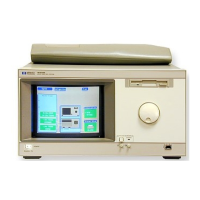Table 9-6 The Status Byte Register
Bit Position Bit Weight Bit Name Condition
7 128 not used
6 64 MSS 0 = instrument has no reason for service
1 = instrument is requesting service
5 32 ESB 0 = no event status conditions have occurred
1 = an enabled event status condition has occurred
4 16 MAV 0 = no output messages are ready
1 = an output message is ready
3 8 LCL 0 = a remote-to-local transition has not occurred
1 = a remote-to-local transition has occurred
2 4 not used
1 2 not used
0 1 MSB 0 = a module or the system has activity to report
1 = no activity to report
0 = False = Low
1 = True = High
*TRG (Trigger)
Command *TRG
The *TRG command has the same effect as a Group Execute Trigger (GET).
That effect is as if the START command had been sent for intermodule group
run. If no modules are configured in the Intermodule menu, this command
has no effect.
Example OUTPUT XXX;"*TRG"
Common Commands
*TRG (Trigger)
9–17

